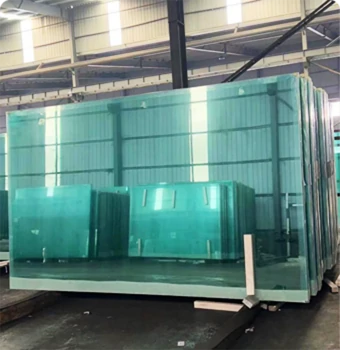Architectural Glassworks The Intersection of Art and Engineering
Architectural glassworks have emerged as a defining feature of modern architecture, seamlessly blending aesthetic appeal with functional design. As cities evolve and the demand for innovative structures increases, glass has become a crucial material in the construction industry. The transformation of architectural glass from mere windows to intricate glass facades, roofing, and interior features represents a significant shift in how we perceive and utilize this versatile material.
One of the most compelling aspects of architectural glassworks is their ability to create a dialogue between the interior and exterior environments. Large glass panels allow natural light to flood into buildings, reducing the need for artificial lighting and promoting energy efficiency. This connection with nature not only enhances the aesthetic quality of spaces but also contributes positively to the well-being of occupants. Studies have shown that natural light can boost productivity, improve mood, and even enhance cognitive function, making it an essential element in modern design.
Furthermore, advancements in glass technology have led to the development of high-performance glass that can meet various functional requirements. For instance, insulated glass units (IGUs) provide thermal regulation, reducing energy consumption for heating and cooling. Additionally, low-emissivity (low-E) coatings reflect heat and UV rays while allowing visible light to enter, contributing to energy-efficient buildings. These innovations mean that architects can design with greater freedom, pushing the boundaries of creativity while adhering to strict energy standards and environmental regulations.
architectural glassworks
Architectural glassworks also facilitate artistic expression in construction. Designers can manipulate glass in various forms, including stained glass, etched patterns, and colorful glass panels. This versatility transforms buildings into works of art, evoking emotion and fostering a sense of identity within urban landscapes. Notable examples include the stunning glass structures at the Glass Pavilion in Toledo, Ohio, and the renowned Louvre Pyramid in Paris. These works illustrate how glass can be used not just as a utility but as a focal point in architectural design.
Moreover, glassworks are not limited to façades and large structures. Interior applications, such as glass partitions, staircases, and canopies, have gained popularity in commercial and residential spaces alike. These elements not only enhance a space's visual appeal but also improve functionality by creating an open, airy environment. For example, glass partitions in offices can promote collaboration while maintaining a sense of privacy. This duality of purpose is a testament to the material's adaptability in various contexts.
However, the use of glass in architecture is not without its challenges. Safety concerns, such as the potential for breakage and the need for structural support, must be addressed during the design and construction phases. Architects and engineers often work together to select the appropriate types of glass and ensure that installations meet safety standards without compromising aesthetics. Additionally, environmental factors such as solar heat gain and glare must be considered, prompting the use of shading systems and smart glass technology that can adjust to changing conditions.
In conclusion, architectural glassworks represent a harmonious blend of artistry, engineering, and innovation. As cities continue to expand and evolve, the role of glass in architecture will only become more prominent. By harnessing its aesthetic qualities and functional benefits, architects can create spaces that not only meet contemporary demands but also inspire and uplift. As the industry moves forward, the future of architectural glassworks promises to be as transparent and luminous as the material itself, inviting us to rethink our built environments and the role of design in our lives.
 Afrikaans
Afrikaans  Albanian
Albanian  Amharic
Amharic  Arabic
Arabic  Armenian
Armenian  Azerbaijani
Azerbaijani  Basque
Basque  Belarusian
Belarusian  Bengali
Bengali  Bosnian
Bosnian  Bulgarian
Bulgarian  Catalan
Catalan  Cebuano
Cebuano  Corsican
Corsican  Croatian
Croatian  Czech
Czech  Danish
Danish  Dutch
Dutch  English
English  Esperanto
Esperanto  Estonian
Estonian  Finnish
Finnish  French
French  Frisian
Frisian  Galician
Galician  Georgian
Georgian  German
German  Greek
Greek  Gujarati
Gujarati  Haitian Creole
Haitian Creole  hausa
hausa  hawaiian
hawaiian  Hebrew
Hebrew  Hindi
Hindi  Miao
Miao  Hungarian
Hungarian  Icelandic
Icelandic  igbo
igbo  Indonesian
Indonesian  irish
irish  Italian
Italian  Japanese
Japanese  Javanese
Javanese  Kannada
Kannada  kazakh
kazakh  Khmer
Khmer  Rwandese
Rwandese  Korean
Korean  Kurdish
Kurdish  Kyrgyz
Kyrgyz  Lao
Lao  Latin
Latin  Latvian
Latvian  Lithuanian
Lithuanian  Luxembourgish
Luxembourgish  Macedonian
Macedonian  Malgashi
Malgashi  Malay
Malay  Malayalam
Malayalam  Maltese
Maltese  Maori
Maori  Marathi
Marathi  Mongolian
Mongolian  Myanmar
Myanmar  Nepali
Nepali  Norwegian
Norwegian  Norwegian
Norwegian  Occitan
Occitan  Pashto
Pashto  Persian
Persian  Polish
Polish  Portuguese
Portuguese  Punjabi
Punjabi  Romanian
Romanian  Russian
Russian  Samoan
Samoan  Scottish Gaelic
Scottish Gaelic  Serbian
Serbian  Sesotho
Sesotho  Shona
Shona  Sindhi
Sindhi  Sinhala
Sinhala  Slovak
Slovak  Slovenian
Slovenian  Somali
Somali  Spanish
Spanish  Sundanese
Sundanese  Swahili
Swahili  Swedish
Swedish  Tagalog
Tagalog  Tajik
Tajik  Tamil
Tamil  Tatar
Tatar  Telugu
Telugu  Thai
Thai  Turkish
Turkish  Turkmen
Turkmen  Ukrainian
Ukrainian  Urdu
Urdu  Uighur
Uighur  Uzbek
Uzbek  Vietnamese
Vietnamese  Welsh
Welsh  Bantu
Bantu  Yiddish
Yiddish  Yoruba
Yoruba  Zulu
Zulu 

